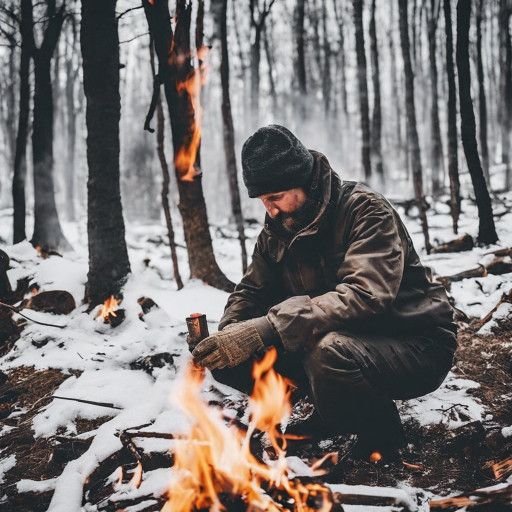Master Proven Techniques for Igniting Fires in Freezing Cold Weather Conditions
Starting a fire in freezing temperatures is not merely a skill but a critical survival tactic when faced with the harsh realities of winter, characterized by bitter cold and relentless winds. As a passionate survivalist, you understand that fire is essential for maintaining body warmth, providing light, and enabling food preparation. However, igniting a fire in icy conditions presents unique challenges that require specialized techniques and know-how. In this comprehensive guide, we will delve into the most effective and dependable methods for successfully creating flames in cold weather, empowering you with the skills and knowledge necessary to overcome winter’s frigid grip and thrive in the wilderness.
Equip Yourself with Essential Gear for Effective Fire Starting
Before embarking on your winter adventures, it’s imperative to arm yourself with the right gear and supplies that can dramatically increase your chances of survival. A well-prepared fire-starting kit can make all the difference in overcoming adverse weather conditions. Make sure to include these essential items in your kit:

a. Reliable Firestarters: Essential tools like waterproof matches, storm-proof lighters, and fire-starting rods are crucial for ensuring ignition, even in harsh conditions characterized by wind and moisture. Having multiple fire-starting methods will boost your confidence and preparedness, enabling you to start a fire no matter the challenges presented by the environment.
b. Dry Tinder Materials: Finding dry tinder in frigid temperatures can be incredibly challenging. To tackle this issue, pack highly flammable items such as birch bark, fatwood shavings, and cotton balls soaked in petroleum jelly. These materials not only ignite quickly but also significantly improve your chances of successfully starting a fire when temperatures plunge below freezing.
c. Quality Kindling: To lay a strong foundation for your fire, gather dry sticks, twigs, and leaves. It’s essential that these materials are completely free from moisture, as any dampness can hinder the ignition process and lead to frustration when trying to ignite a flame. Properly prepared kindling is crucial for transitioning from tinder to a more robust fire.
d. Sufficient Fuel Supply: Securing dry firewood in freezing conditions can be both exhausting and time-consuming. Therefore, having a ready supply of dry firewood is vital for maintaining a consistent fire for an extended period, enabling you to stay warm and comfortably cook your meals.
Select the Optimal Location for Your Fire to Enhance Efficiency
When temperatures drop, selecting the perfect location for your fire can provide significant advantages. Look for sheltered spots, such as rock formations or dense shrubs, to reduce exposure to harsh winds. By positioning your fire near a natural windbreak, you minimize heat loss and improve your chances of maintaining a steady flame. Additionally, consider constructing a small wind-resistant shelter using logs or a tarp to shield the fire from precipitation and retain warmth, ultimately enhancing your comfort and safety in the outdoors.
Utilize the Layering Technique for Sustained and Efficient Fires
One fundamental technique for successfully starting a fire in cold conditions is mastering the art of layering your materials. To create a fire that burns consistently, you must utilize three foundational layers: tinder, kindling, and fuel. Here’s a detailed overview of each layer and its importance:
a. Tinder Layer: The first layer, tinder, consists of materials that ignite quickly and effortlessly. Use fine, dry substances like grass, paper, or the aforementioned birch bark to ensure a strong initial flame. Having an adequate amount of tinder is essential for achieving successful ignition, particularly in cold environments where conditions can be unforgiving.
b. Kindling Layer: This layer comprises small sticks and twigs that catch fire rapidly and provide sustained heat. Gradually add kindling to your flame, ensuring ample space between pieces to promote airflow and encourage combustion. This step is crucial for transitioning from small flames to a larger, more stable fire, which will provide warmth and comfort.
c. Fuel Layer: Once a steady flame has been established, progressively introduce larger pieces of firewood. Ensure the wood is dry, as it will burn longer and generate more heat. Gradually increase the size of the wood pieces, allowing the flames to strengthen before adding larger logs. This strategic approach to layering your fire encourages a stable and sustainable flame that will keep you warm.
The technique of layering your fire creates a structured setup that allows the flames to expand and sustain themselves effectively. Always ensure you have an ample supply of each component readily available to facilitate a seamless transition from tinder to fuel, guaranteeing a successful fire even in challenging conditions.
Enhance Your Fire-Starting Potential with Proven Aids and Techniques
In extremely cold weather, using additional fire-starting aids can greatly boost your chances of successfully igniting a fire despite the challenges posed by low temperatures. Here are some effective methods to consider:
a. Fatwood as a Natural Firestarter: Renowned as nature’s firestarter, fatwood is resin-infused pine wood that ignites with ease and burns with intense heat. You can gather these naturally occurring sticks from fallen pine trees or purchase them from outdoor supply stores. A few pieces of fatwood can dramatically enhance your fire-starting success in particularly cold conditions.
b. Alcohol-Based Hand Sanitizer: Surprisingly effective, alcohol-based hand sanitizer is highly flammable and serves as an excellent accelerant. A small amount applied to your tinder or kindling can help ignite a fire quickly, even in damp weather, simplifying the fire-starting process and ensuring you stay warm when it matters most.
c. Char Cloth for Quick Ignition: Char cloth is a specially prepared fabric that ignites easily from sparks, making it an invaluable tool for starting fires using flint and steel or a lighter in tough situations. Its lightweight and portable nature makes it an ideal addition to your fire-starting kit, ensuring you are always prepared for any scenario.
Incorporating these fire-starting aids into your cold-weather toolkit can significantly improve your chances of success when facing particularly challenging conditions, allowing you to adapt to the environment effectively and ensure your safety.
Explore Effective Fire Techniques Tailored for Cold Weather Conditions
As a committed survivalist, continuously honing your skills is crucial for your success. Here are two fire techniques that excel in cold weather conditions:
a. Master the Swedish Torch Technique: Also referred to as a Canadian Candle or Finnish Fire Log, the Swedish Torch is an incredibly effective fire-starting method. This technique provides a stable and long-lasting flame, ideal for combating the chill of winter. To create a Swedish Torch, find a log about knee-height and cut several vertical slits along its length. Place tinder in the slits and ignite it. The log will serve as a consistent fuel source, allowing the flame to endure for an extended period, ensuring warmth and safety.
b. Utilize the Dakota Fire Hole Method: When faced with strong winds, the Dakota Fire Hole method is highly effective. This technique involves digging a hole and tunneling horizontally underground to create an airflow vent. This design harnesses wind to enhance airflow, resulting in a more efficient fire that is less likely to be disrupted by gusts. Furthermore, the Dakota Fire Hole method effectively reduces visible smoke while conserving fuel, making it an excellent choice for discreet fire building.
Regardless of the method you choose, always prioritize safety and responsible fire management to minimize risks and ensure a successful fire-starting experience.
Successfully igniting a fire in cold weather necessitates meticulous planning and execution. By following these steps—preparing a reliable fire-starting kit, selecting an appropriate location, mastering layering techniques, utilizing fire-starting aids, and embracing specific fire strategies—you will significantly enhance your chances of success. Remember, practice makes perfect, so consistently train to refine your skills and boost your confidence. With these essential tactics for igniting fires in freezing conditions in your toolkit, you’ll be well-prepared to face even the harshest winters that nature has to offer. Stay warm, prioritize your safety, and keep the flames of survival alive!
The post Fire Starting Methods for Survivalists in Cold Weather appeared first on Survival Bite.
The Article Fire Starting Techniques for Cold Weather Survival Was Found On https://limitsofstrategy.com


Ah, the art of fire-starting in winter—it’s basically the adult version of trying to convince your car to start when it’s colder than your ex’s heart! I remember my first experience trying to light a fire in sub-zero temps. Let’s just say I learned the hard way that rubber gloves do not double as fire-starting tools. The right gear really is a game changer. And speaking of gear, have you looked into using fire starters made from pine sap? They work like magic!
You nailed it with that comparison—winter fire-starting can feel like a battle sometimes. I’ve had my share of struggles too, standing there, frustrated, with everything working against me. And using rubber gloves? That’s a classic rookie move. It’s amazing how the right gear can make a world of difference. I’ve found that a good pair of fireproof gloves is essential for handling kindling without worrying about burns.